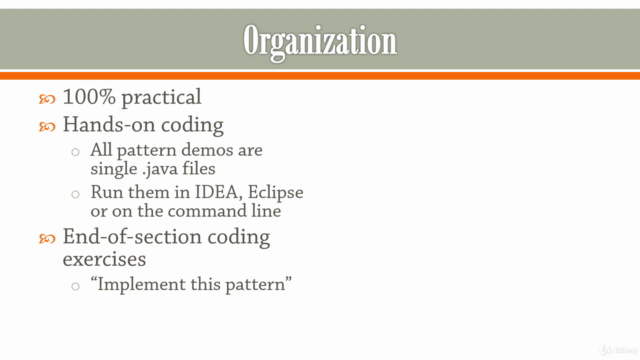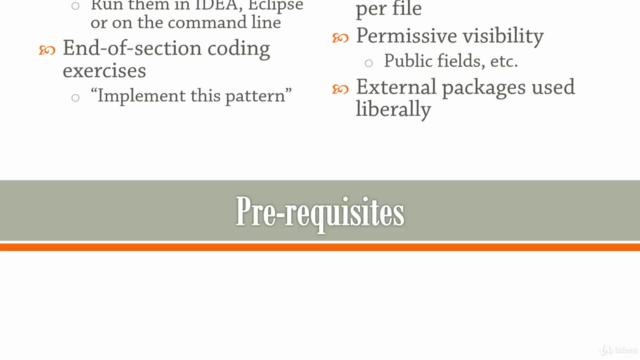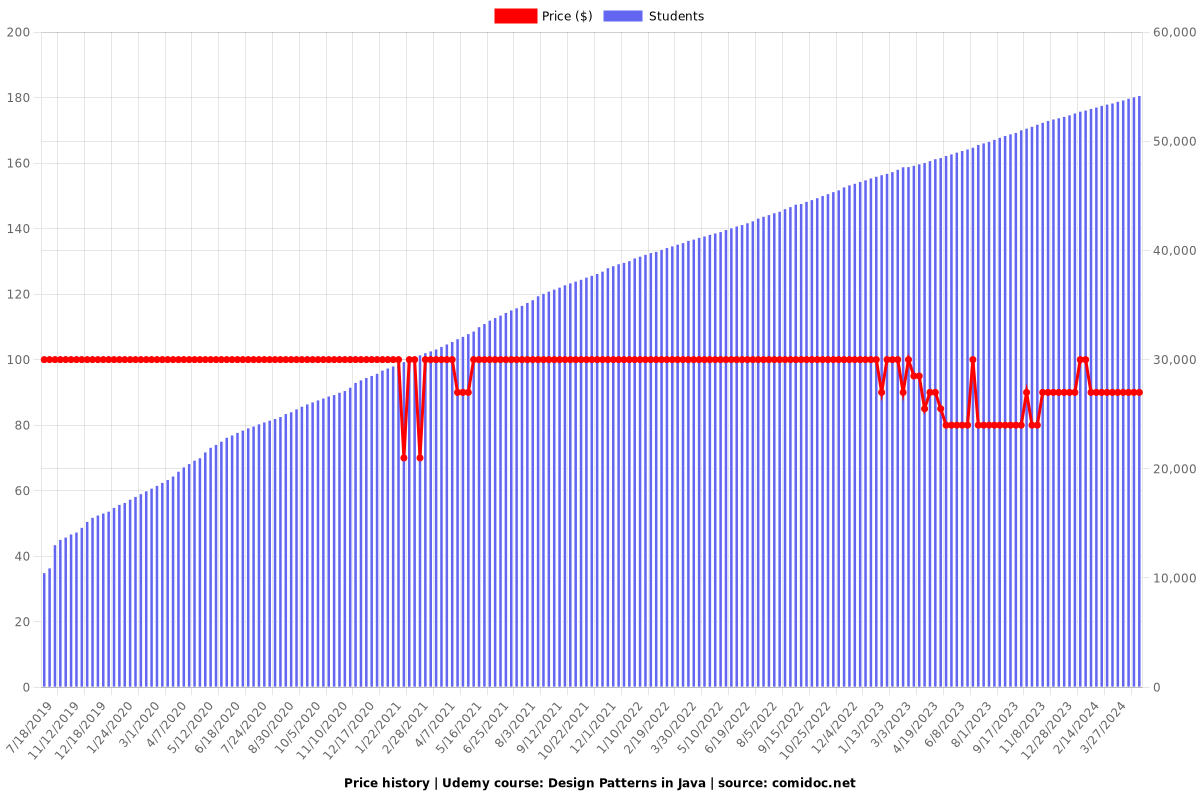Design Patterns in Java
Discover the modern implementation of design patterns in Java
4.50 (8383 reviews)

54,087
students
10.5 hours
content
Apr 2020
last update
$89.99
regular price
What you will learn
Recognize and apply design patterns
Refactor existing designs to use design patterns
Reason about applicability and usability of design patterns
Why take this course?
🎓 **Master Design Patterns in Java with Dmitri Nesteruk**
---
### **Course Overview 🚀**
Dive deep into the world of **Design Patterns in Java** with this practical-focused course. Explore how these patterns are implemented using the latest versions of Java, incorporating modern programming techniques like dependency injection, reactive programming, and leveraging advanced developer tools such as IntelliJ IDEA. This course also delves into pattern variations and alternative approaches for a comprehensive understanding.
- **Java Versions:** Latest updates and features
- **Modern Programming Techniques:** Incorporating dependency injection, reactive programming
- **Developer Tools:** Utilizing IntelliJ IDEA effectively
- **Pattern Variations:** Exploring modern variations of GoF patterns
---
### **What are Design Patterns? 🧠**
Design Patterns are timeless solutions to common software design problems. Popularized by the seminal work "Design Patterns: Elements of Reusable Object-Oriented Software" by the Gang of Four (GoF), these patterns have been adapted and implemented across various programming languages, not just C++ and Smalltalk as originally discussed.
The enduring relevance of design patterns lies in their ability to be found in libraries, embedded within programming languages, and used daily without conscious realization. They are the DNA of well-architected software systems.
---
### **What Patterns Does This Course Cover? 📚**
This comprehensive course covers all the GoF design patterns and more. Get ready to explore a wide range of patterns, including:
- **SOLID Design Principles**
- **Creational Design Patterns**
- **Structural Design Patterns**
- **Behavioral Design Patterns**
Here's a sneak peek at the patterns we'll cover:
- **SOLID Principles:** Single Responsibility Principle, Open-Closed Principle, Liskov Substitution Principle, Interface Segregation Principle, Dependency Inversion Principle
- **Creational Patterns:** Builder, Factory Method, Abstract Factory, Prototype, Singleton
- **Structural Patterns:** Adapter, Bridge, Composite, Decorator, Façade, Flyweight, Proxy
- **Behavioral Patterns:** Chain of Responsibility, Command, Interpreter, Iterator, Mediator, Memento, Null Object, Observer, State, Strategy, Template Method, Visitor
---
### **Who Is the Course For? 👩💻**
This course is tailored for Java developers who aspire to master design patterns by seeing real-world applications and variations. Whether you're a beginner or an experienced developer, this course will guide you through implementing patterns with modern techniques, ensuring your code is both efficient and maintainable.
---
### **Presentation Style 📽**
The course is delivered through engaging live demonstrations within IntelliJ IDEA, enhanced by the Kinetica rendering engine for an immersive learning experience. You can enjoy crystal-clear code visualization whether you're on a desktop or mobile device.
Most demos are self-contained single-file examples that you can download and run in your preferred IDE, such as IntelliJ, Eclipse, and more. This hands-on approach ensures you can practice and apply the concepts in real-time.
---
### **Key Features 🖥️**
- **Real-World Examples:** No theoretical fluff – only practical, applicable knowledge.
- **Modern Implementations:** Learn how to use design patterns with Java's modern features and tools.
- **Live Coding Demonstrations:** Understand patterns by seeing them implemented in real-time.
- **Single-File Examples:** Download, run, and experiment with the code provided for each lesson.
- **No UML Diagrams:** Focus on practical coding rather than diagrams (though they're important too!).
- **IntelliJ IDEA Integration:** Learn with one of the most popular Java IDEs out there.
- **Maven Usage:** Explore how Maven packages can streamline your development process.
---
Join Dmitri Nesteruk in this enlightening journey through the world of design patterns in Java, and elevate your programming skills to new heights! 🚀✨
Screenshots




Our review
---
**Overall Course Rating**: 4.50/5
**Course Review Summary**:
The online course on Design Patterns has received a generally positive reception from its audience, with an average global rating of 4.50 out of 5 stars. The majority of recent reviews indicate that the course is well-presented and the instructor demonstrates a deep understanding of the material. However, there are common themes in the feedback that highlight areas for improvement, particularly regarding the complexity of the examples used, the pace at which the material is delivered, and the difficulty of the coding exercises.
**Pros**:
- **Expertise of Instructor**: The instructor's knowledge of the subject matter is commended across various reviews.
- **Comprehensive Content**: Concepts are explained in full, with complete explanations that cover the core principles effectively.
- **Useful Coding Exercises**: Many reviews praise the practical coding exercises for reinforcing the concepts learned.
- **High Production Quality**: The course is well-produced and offers a pleasant learning experience.
- **Coverage of Real-life Applications**: The course provides numerous variations and real-world applications of design patterns, which is highly valuable for practical implementation.
**Cons**:
- **Complex Examples**: Numerous reviews note that the examples used are often too complex for beginners or those new to design patterns, making it difficult to understand the core concepts.
- **Pacing Issues**: Some learners find the instructor's pace too fast for the intricate material being covered, necessitating repeated viewings or slowing down of videos.
- **Difficulty of Exercises**: The coding exercises are considered either too easy, lacking application of the design patterns, or too difficult, requiring knowledge of specific frameworks not explicitly taught.
- **Lack of Support**: A few reviews mention the absence of solutions for the exercises and the need for clearer guidance on where to find code examples related to the lectures.
- **Unclear Assessment Criteria**: There is feedback suggesting that the practice coding tests are overly complex and not clearly graded, making it unclear how to pass or improve performance.
- **Potential Boredom**: Some learners express a desire for more engaging elements such as animations, diagrams, or humor to complement the textbook-like approach of the course.
**Additional Feedback**:
- **Pace and Clarity**: "The instructor really knows the material, but I found the pace of his speaking was rather fast for such complicated material. Expect to have to review segments and/or slow down the videos, and incorporate that into your expected learning time."
- **Complexity of Material**: "Easy things made difficult; author though spent time to make this course but forgot about the audience."
- **Need for Simplified Examples**: "It is probably a good course, but additional exercises would improve it. I found it a bit boring..."
- **Exercise Complexity**: "This section is amazing but please give add one or two more example which really helps to get clear understanding. Like the examples used in the lectures, they should be more straightforward and less complex."
- **Practical Application**: "Too much coding and unnecessary coding exercises, which can't handle based on too much coding. You should give more explanation about design patterns and code according to that."
**Recommendations for Improvement**:
- **Adjust Example Complexity**: Simplify the examples used in lectures and coding exercises to better suit learners at different levels of expertise.
- **Improve Exercise Design**: Ensure that the coding exercises are appropriately challenging, provide clear instructions, and include solutions or guidance.
- **Clarify Assessment Criteria**: Clearly define what is expected for the practice coding tests and how learners can achieve a passing grade.
- **Enhance Engagement**: Consider adding more engaging elements to the course content to maintain learner interest and aid in comprehension.
**Conclusion**:
The Design Patterns course offers a wealth of information and practical application, with an expert instructor and comprehensive coverage of the subject matter. However, it would benefit from a reevaluation of the complexity of examples used and the design of exercises to ensure that all learners can effectively engage with and complete the material. With these adjustments, the course has the potential to be an even more valuable resource for those interested in learning about design patterns.
Charts
Price

Rating

Enrollment distribution

Related Topics
1358570
udemy ID
9/23/2017
course created date
7/18/2019
course indexed date
Bot
course submited by